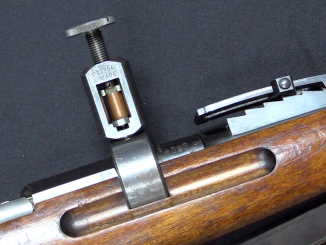In 1925 the USSR began a program to develop a heavy machine gun for antiaircraft use. After some initial experimentation with a converted Dreyse machine gun, they brought in Degtyarev to scale up his recently-adopted light machine gun to the task. Degtyarev’s first design was ready in 1930, and underwent testing until 1933. It was designated the DK, and used a 30-round drum magazine. This contributed to an unacceptably low rate of fire (~360 rpm), and the feed system was replaced by an ingenious development of Georgiy Shpagin to use belts instead.
Fitted with the Shpagin feed system, the DShK finished field testing in 1939 and was adopted as the model 1938. Production was slow, and the guns were not used on anything like the scale of American M2 use during World War Two. A total of about 9000 were in use at the end of the war, although the subsequent update to the DshKM (aka DShK 38/46) pattern would see it fitted to many armored vehicles, and total production eventually topped one million.
This example is a very early production 1939 example, most likely a Finnish capture piece from the Winter War or Continuation War.




“(…)converted Dreyse machine gun(…)”
Photos of 5.П.II can be seen here https://www.kalashnikov.ru/po-sheme-drejze-2/
“(…)DK(…)30-round drum magazine(…)”
Photo can be seen here http://modernfirearms.net/en/machineguns/russia-machineguns/dshk-i-dshkm-12-7-eng/ observe that said magazine is sticking to top, which is uncommon for drum magazines.
“(…)~360 rpm(…)”
My cursory search revealed Rate-of-Fire of DK to be generally described as up to 450 rpm, e.g. https://kpfu.ru/chemistry/vov75/chemistry-vov75-8.html what is source of 360 rpm?
Thanks for the pictures. I love how the base can be used for both ground support and anti-aircraft use. I am not sure that any other HMG design was this clever. Usually a setup is only for one use and can’t be switched back and forth without lugging around extra mounts.
Soviet designs are considered crude, but somebody had a good day with this one.
No Utreon release?
Really wonderful systematic presentation as usual!. Thanx
I like the DShK, and now I feel I know a lot more about it. The Shpagin rotary belt feed was very interesting.
I also liked seeing the flapper locking system. It really is a scaled up DP, fundamentally a simple system, and nothing wrong with that.
I have always been intrigued by the gap along the gas tube on the DShK. I can only assume this is to release excess gas from the system, is this right?
I think DShKs is a treasure in all wars. After World War II, DShKs were used widely by communist forces in Vietnam, starting with the Battle of Dien Bien Phu in 1954. While not as powerful as anti-aircraft cannons, the DShK was easier to smuggle through Vietnam, Cambodia and Laos. DShKs were a major threat to American aircraft in the Vietnam War,and of the 7,500 helicopters and fixed-wing aircraft lost during the war, most were destroyed by DShKs. This gun is also simulated in cubes 2048. I tried it and it can shoot down enemies with one shot.